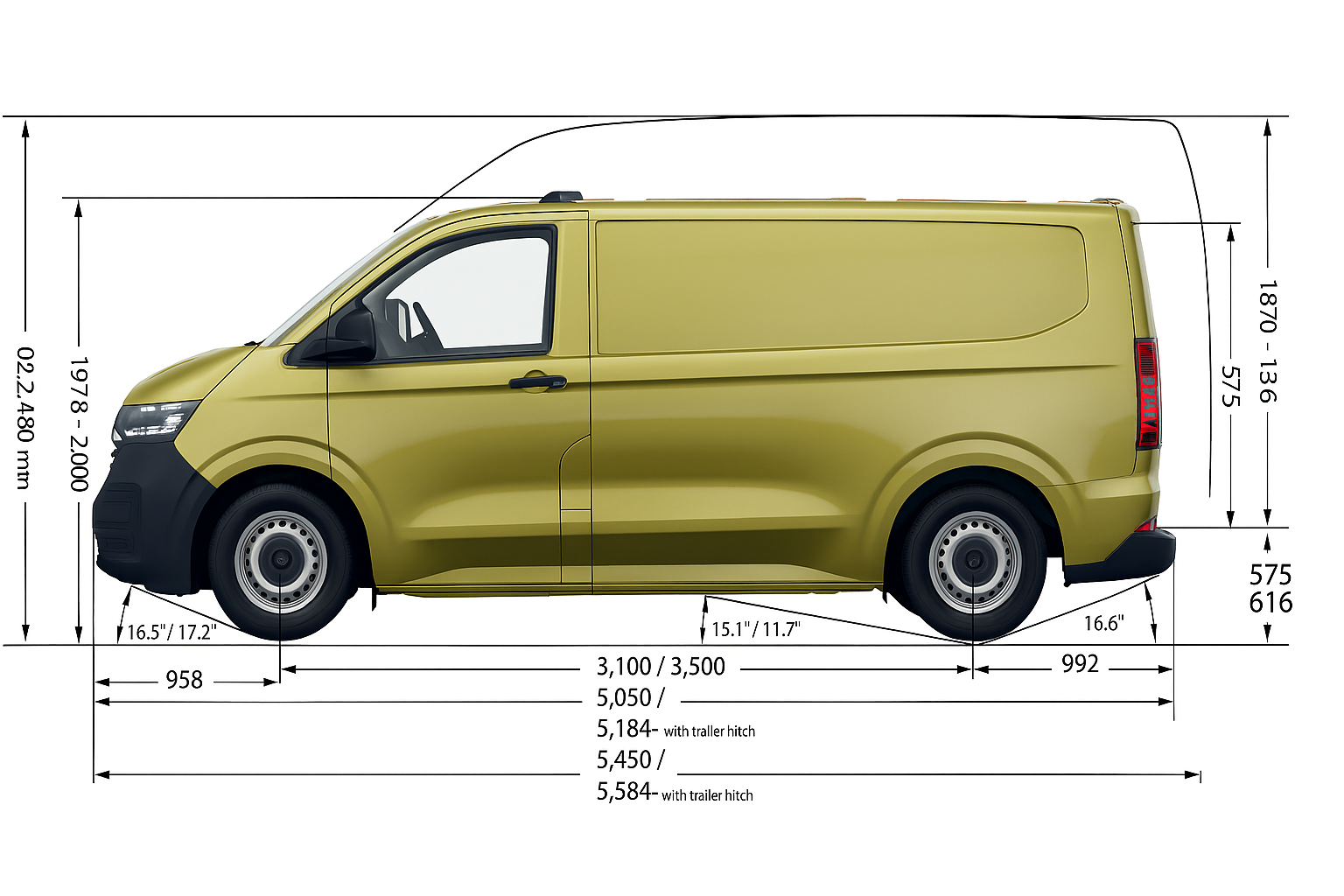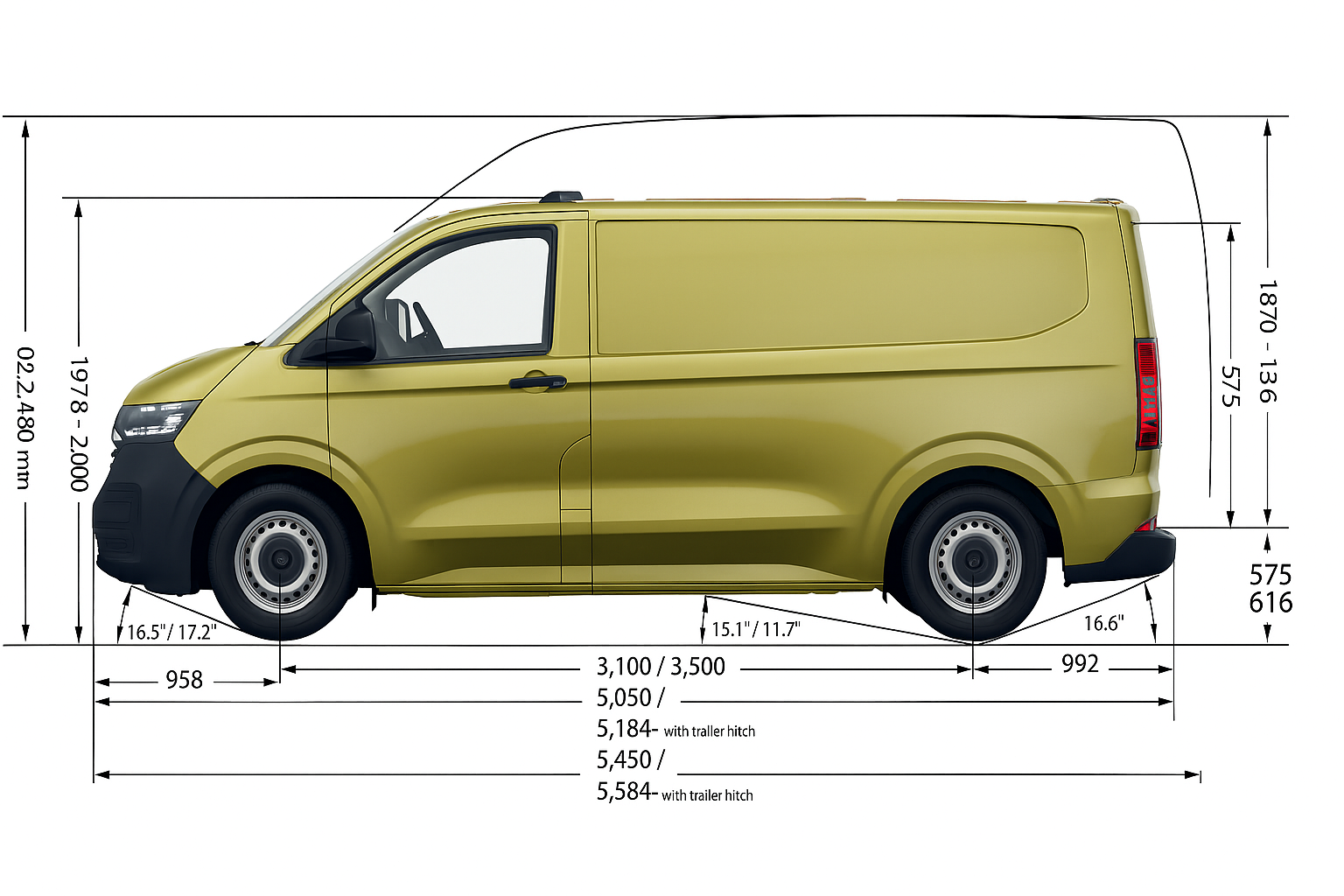Whether used for business, adventure, or daily tasks, the physical size of your van can shape your experience as much as the badge on its grille. The VW Transporter, a stalwart on European roads since the 1950s, has become a benchmark for versatility. Every generation is sculpted to balance comfort, load capacity and city-friendly agility. Yet within one model year, a variety of body styles can lead to confusion when calculating just how much you can carry, or whether the van will fit where you need it to be.
Let’s break down the key variants—Short Wheelbase (SWB), Long Wheelbase (LWB), Low Roof and High Roof—and see how these figures relate beyond the spec sheets.

First Impressions: Why Size Truly Matters
That iconic ‘T’ van silhouette carries a surprising spectrum of personalities. The SWB and LWB choices aren’t just for appearance; they’re fundamental to how much you can haul and where you can park.
Tasks as small as choosing a shelving system, or as significant as fitting out for wheelchair access and sleeping arrangements, come down to sheer millimetres. Companies and private owners alike seek the sweet spot between capacity and manoeuvrability, longevity and everyday convenience.
At a Glance: Comparing Key Measurements
Here’s a side-by-side view of the core dimensions (for latest generation panel van):
A few figures jump out immediately, but the real intrigue begins when relating them to actual use-cases.
Load Volume and Cargo Space: Beyond the Numbers
For many, the focus is on the cubic metre ratings. The SWB low roof’s 5.8m³ is ample for most day jobs—plumbers, bakers, or couriers navigating city streets. The LWB low roof offers an extra 0.9m³ of capacity, thanks in large part to a wheelbase that’s 400mm longer.
When height is paramount, the LWB high roof becomes a different animal. A jump to 9.3m³ can make all the difference when transporting tall shelving, large appliances, or even kitting out the rear as a compact campervan.
Some quick comparisons:
The high roof gives a staggering 530mm extra standing room compared to its low roof siblings, easily enough for most adults to stand upright.
The load length gain in the LWB models (from 2572mm to 2975mm) translates to longer items fitting without a diagonal arrangement—ideal for ladders, skirting boards, or rolled flooring.
Width and Practicality: The Real-World Fit
A load width of 1700mm, narrowed to 1244mm between the wheel arches, is a consistent figure across all bodies. This consistency is a selling point, especially for those fitting ply lining, racking, or needing to roll in a full-sized euro pallet.
Pay attention to these common packing scenarios:
Euro Pallet (typically 1200mm x 800mm) fits snugly between the arches.
Sheet materials (like plasterboard or plywood, typically 1220mm wide) slide in flat without awkward angling.
For those carrying motorcycles, e-bikes, or bulky tools, that extra space outside the arches means cargo can be placed securely, optimising space without the risk of rubbing against wheel housings.
Doorways and Easy Loading
Getting cargo in and out smoothly is often more significant than sheer volume. Both the SWB and LWB models offer a side door opening of just over a metre wide, enough to accommodate wide boxes or mobility aids.
For anyone considering a high-roof van, the optional side door stretching up to 1734mm in height is a small revolution for tall, awkward items. The rear doors, too, balloon in height on the high-roof setup, making for easy loading of furniture or stacked parcels.
Comparing rear access:
With high-roof models, there’s a notable leap in door height, but keep in mind the opening width remains identical. Those working with wide but shorter items shouldn’t worry, but extremely tall,
Manoeuvring Around Town
Parking tight or weaving through side streets, the wheelbase and turning circle are frequent sources of concern for drivers more used to smaller vehicles. The short wheelbase’s circle of just under 12 metres keeps it nimble, whereas the LWB needs more space—just over 13 metres.
This isn’t just an academic difference:
Parallel parking spots become harder to exploit in the LWB.
Multi-storey car parks and tight urban service bays may be restrictive for the longer, high-roof option.
Country lanes and loading docks with limited room for error will reward those choosing the SWB configuration.
Floor Area and Perfect Use Cases
Those planning intricate storage solutions, fold-out beds or mobile workshops will want to match their vision with the available floor area.
SWB Low Roof: 4.3m²
LWB Low Roof/High Roof: 5.0m²
These floor areas may not sound transformative, but even a fraction of a square metre opens up options. A small shelving unit, an extra courier crate or an additional suitcase for those using it as a camper can make the difference between convenience and inconvenience.
Load Volume for Business and Leisure
Carrying capacity isn’t just a figure to fill spreadsheets—it shapes flexibility, the ability to say ‘yes’ to more work or travel opportunities. Here’s how you might decide:
If your typical loads are mixed but never extreme in scale, the SWB low will almost always be easier to handle.
LWB lows let you take on bulkier contracts or comfortably double as a trade van and a family shuttle.
High roof LWB models dramatically expand the versatility, transforming the interior into a mobile office, mini camper or expansive delivery port.
Every choice in the Transporter catalogue is about trade-offs: capacity versus convenience, or outright size versus subtlety.
Dimensions in Perspective
It’s tempting to focus entirely on length, width and height, but the usable space can be influenced by the fine details: door openings, wheel arch intrusion, roof height, and whether you’ll be operating in city centres or open country.
Some practical scenarios to ponder:
Tradespeople running racks along the length can thrive with an LWB setup.
Couriers needing quick, easy exits at kerbside benefit from smooth, wide side door access.
Family campers planning conversions prioritise height, seeking both sleeping and storage zones above the floor.
On the Road: Driving Dynamics and Accessibility
Taller and longer vans tend to shift the character towards stability and comfort at the expense of tight parking. The current Transporter manages to strike an impressive balance. Suspension, steering weight and seating position have all been refined with city limits and cross-country treks in mind.
Accessibility stands out thanks to:
Broad, step-access doors at the side.
Load height that allows even the high-roof version to remain manageable at most warehouses and ferry boarding ramps.
How to Choose Your Perfect Fit
So many configurations might seem overwhelming, but those numbers tell a story about how the van will work with your life or business. Prioritise what matters most:
City usage: Shorter wheelbase, lower roof for versatility and parking.
Occasional big hauls: LWB gives extra flexibility, especially for trades and removals.
Standing room and conversion plans: Go for high roof, and never look back.
With the right dimensions, a Transporter is more than just wheels and metal panels; it becomes a reliable, adaptable partner. The figures are not just technicalities—they are the foundation to a host of opportunities, both working and personal. Let each measurement reflect your ambitions.
